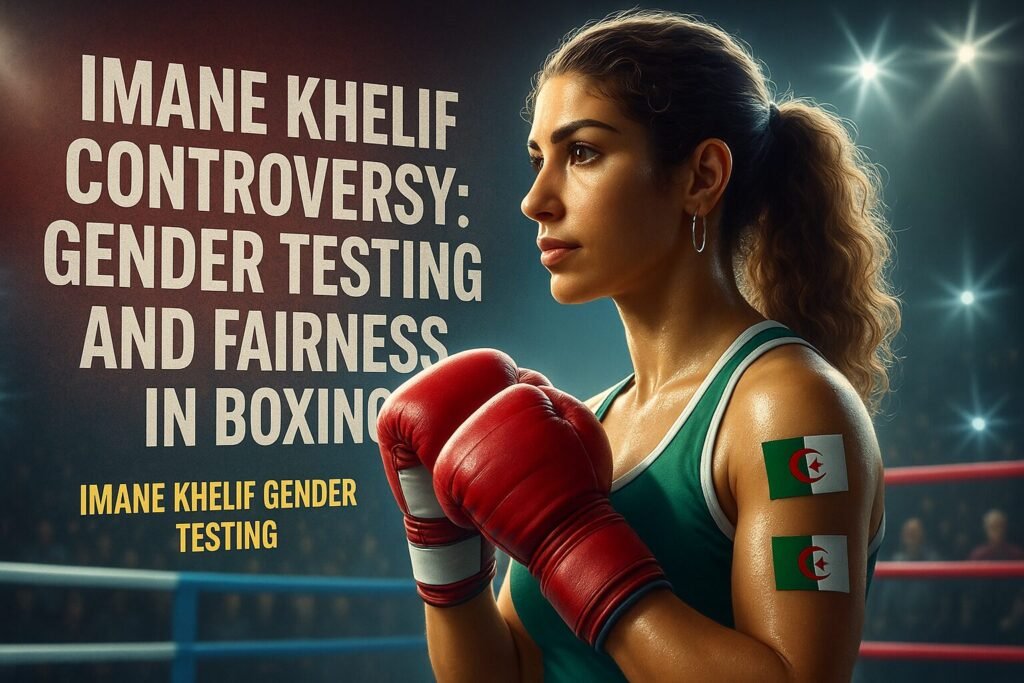The controversy surrounding Algerian boxer Imane Khelif has once again thrust boxing into the centre of a much wider societal debate. After being barred from the upcoming Eindhoven Box Cup, Khelif has been told she must undergo mandatory sex testing under new eligibility rules introduced by World Boxing — the recently IOC-recognised rival to the International Boxing Association (IBA).
The decision has stirred intense debate. Some are calling it a necessary step to protect fairness and safety in the ring. Others see it as a discriminatory policy that alienates athletes who don’t fit neatly into traditional definitions of sex or gender.
Whichever side you lean toward, this isn’t a discussion boxing can afford to ignore.
What’s Happened with Imane Khelif?
Khelif is no stranger to controversy. In 2023, just before her Olympic campaign, she was disqualified under similar circumstances — a story we covered at the time on CMBoxing: “Imane Khelif Olympic Disqualification”. That post explores the original fallout and the questions that arose around her eligibility to compete in the women’s category.
Now, with World Boxing taking a firmer stance on athlete classification, Khelif has once again found herself excluded from competition unless she complies with newly enforced sex testing protocols. According to the organisation, the aim is to ensure a level playing field and protect the wellbeing of athletes, especially in a full-contact sport like boxing.
But let’s not pretend this is just about boxing — this is a cultural and ethical fault line playing out across every corner of sport.
Why Is Sex Testing Such a Big Deal?
Sex testing is one of the most emotionally charged and controversial tools in sport today. At its core, the idea is simple: verify that athletes competing in a given category meet the biological criteria required to ensure fair and safe competition. But the execution? Far from simple.
For starters, sex and gender are not the same thing — a point often lost in public debate. Many athletes may identify as women, and live their lives as women, but still possess biological traits — such as testosterone levels or muscle density — that some experts argue provide an unfair advantage in a sport like boxing.
That’s especially relevant here. Unlike track or swimming, where physical advantages may influence speed or endurance, boxing is about physical impact. It’s about how much punishment a fighter can absorb and dish out. The difference between a fair contest and a dangerous mismatch can be razor-thin.
This isn’t about questioning someone’s identity. It’s about protecting fighters — especially female athletes — from unnecessary risk.
What’s World Boxing’s Justification?
World Boxing, now formally recognised by the International Olympic Committee, has taken a hard line where the IBA has largely resisted change. Their updated eligibility policies require that boxers competing in women’s divisions meet strict biological criteria, including sex assigned at birth or medically defined classifications based on hormone levels and physiological traits.
To many fans, that might seem like common sense. But to critics, it’s a slippery slope. Who decides what qualifies as “biologically female”? Where do we draw the line between inclusion and exclusion? And most importantly — how do you enforce these rules without invading athletes’ privacy or causing lasting harm?
A Wider Sporting Trend
Boxing is far from alone in grappling with this. Athletics, swimming, rugby, cycling — all have introduced rules in recent years around transgender and intersex athlete participation. Some, like World Athletics, have introduced strict testosterone limits. Others, like FINA in swimming, have gone further, instituting near-total bans on transgender women competing in elite women’s events.
Meanwhile, the IBA has floated the idea of a separate “open category” for athletes who don’t fit the traditional male/female binary, but progress has been slow, and most federations still lack clear pathways for these athletes to compete at the highest level.
In that context, World Boxing’s approach is both consistent with wider sporting trends and controversial by design.
Between Inclusion and Integrity: No Easy Answer
Let’s be real: this is a near-impossible balancing act. You can make a strong case that biological women deserve a safe, fair environment to compete. You can also make a strong case that forcing an athlete to undergo sex testing — potentially against their will — is discriminatory and dehumanising.
Both things can be true at the same time.
Personally, I agree with World Boxing’s stance — but purely on safety grounds. In a sport as dangerous and physically demanding as boxing, the consequences of mismatched strength and physiology can be life-altering. That said, I also believe there’s a better long-term solution that doesn’t force anyone to choose between their identity and their sport.
That solution? A separate, fully supported open category for transgender athletes — not just in boxing, but across all sports. It would allow everyone to compete on equal terms, with dignity, without compromising safety or fairness. That kind of structural inclusion takes time, resources, and political will — but if we’re serious about inclusion, it’s the next logical step.
Let’s Talk — Because This Debate Is Only Just Beginning
This is bigger than any single boxer or bout. It’s a conversation about the future of sport — one that demands nuance, compassion, and courage from everyone involved. Whether you agree with the new rules or not, it’s clear the sporting world needs to evolve, not just react.
What Do You Think?
Do you agree with World Boxing’s stance? Should fighters like Imane Khelif be required to undergo gender testing — or is that a step too far? And would an open category actually help fix the problem, or just create more division?
Join the conversation below, share this article, and head over to CMBoxing.co.uk for more honest, no-punches-pulled takes on boxing’s biggest issues.

